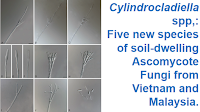Placoderms are thought to have been the earliest jawed Vertebrates, first appearing in the Silurian and rising to become the most diverse group of Fish in the Devonian, before their extinction at the end of that period. During the Devonian the Placoderms, and in particular the Arthrodires (the most abundant and diverse Placoderm group) produced a wide range of forms, implying an equally diverse range of ecological and feeding strategies. However, Placoderms are known almost entirely from their hard parts, with only a single specimen with a body outline known, and no known stomach contents or soft parts, limiting our ability to interpret the ecology of these diverse early Fish. The jaws of early Placoderms show tend to be similar, apparently adapted to rapid snatching of prey, but later members of the group are much more varied, and have been interpreted to reflect a range of feeding styles from filter feeding to durophagy (the crushing of hard foodstuffs, such as shellfish).
In a paper published in the journal Royal Society Open Science on 31 January 2024, Melina Jobbins of the Department of Palaeontology at the University of Zurich, Martin Rücklin of the Naturalis Biodiversity Cente and the University of Leiden, Marcelo Sánchez Villagra, also of the Department of Palaeontology at the University of Zurich, Hervé Lelièvre of the Muséum National d’Histoire Naturelle, Eileen Grogan of the Department of Biology at Saint Joseph’s University, Piotr Szrek of the Polish Geological Institute, and Christian Klug, again of the Department of Palaeontology at the University of Zurich, redescribe a species of Late Devonian Placoderm previously only known from fragmentary material from the Holy Cross Mountains of Poland, on the basis of new material from the eastern Anti-Atlas of Morocco.
Alienacanthus malkowskii was originally described from fragmentary material from two quarries in Poland, as composing large, possibly paired, spines of uncertain origin. Jobbins et al.'s redescription of the species is based upon a nearly complete skull, the left side of a second skull, and a number of more fragmentary remains from sites in Morocco, which reveals the 'spines' to be part of the lower jaw of a large Eubrachythoracid Placoderm.
The inferognathal bones, which form the lower jaws in Placoderms protrude significantly beyond the upper jaw, reaching about twice the length of the rest of the skull, reaching a pointed tip. These jaw elements run closely parallel to one-another over about 60% of their length, although they are not fused at any point. The teeth of both jaws are posteriorly recurved, with the 'teeth' (actually bony protrusions, as in all Placoderms) of the lower jaw continuing forward of the upper jaw, but a significant distance short of the tip of the bone.
Extremely elongated lower jaws are known in a variety of other extant and fossil Fish and marine Tetrapods, including the Carboniferous Chondrichthyan Ornithoprion, the extant ray-finned Halfbeaks, which have a fossil record dating back to the Palaeogene, and the Pliocene Porpoise Semirostrum. Although in none of these are the lower jaws as elongated as they are in Alienacanthus malkowskii, with the longest examples being found in some species of Halfbeak, which can reach about 1.6 times the length of the skull.
The recurved teeth of Alienacanthus malkowskii are strongly suggestinve of a diet of live Fish, mirroring the shape of teeth seen in many other Fish-eating groups, including Ichthyosaurs, Snakes, Choristoderans, and other living and extinct Fish species. However, the lower teeth of Alienacanthus malkowskii continue beyond the upper jaw, with up to twelve teeth forward of the mouth in observed specimens.
Teeth forward of the mouth are known in a number of Condrichthyan groups, including Sawfish, Sawsharks, and Rajiform Rays. All of these have teeth on the upper jaw rather than the lower, and are equipped with electroreceptive sensory organs which enable them to detect prey-Fish and strike them with a rapid side-motion of the rostrum. However, thin sections of the jaw of Alienacanthus malkowskii show no signs of the additional neural canals which would be associated with such a system, and the teeth of Alienacanthus malkowskii are directed upwards, rather than sideways, making it unlikely that the elongated jaw was used in the same way as seen in Sawfish. Instead, Jobbins et al. suggest that the presence of teeth forward of the mouth in Alienacanthus malkowskii is a product of the way the living Animal grew, with formerly useable oral teeth being carried forward as the jawbone elongated, probably in a short burst of growth as the Fish approached maturity, although it is still possible that the long lower jaw was used to strike at prey, and that the forward teeth could have inflicted damage on soft-bodied Animals.
See also...





















.jpg)






































